For clients who have spent time at a drug and alcohol inpatient treatment facility, going directly home may not be the best choice. To go directly from having a high level of support to being completely independent could put a newly-sober person at risk for a relapse. A much better choice for sober recovery is to take the process slowly and continue to get support from trained counselors on an outpatient basis for a time after leaving the facility.
At first, it may appear as though the person in recovery is spending time just having fun, since the sober social activity list includes a number of enjoyable outings. People in recovery need to keep their days full so that they don’t have any “down” time. If they get bored or have a lot of time to themselves, they may be tempted to start drinking or using drugs or alcohol.
Moving on After Treatment for Drug and Alcohol Addiction
A client who decides to move into a sober living house who is also unemployed may need assistance to find work. This is part of moving on after treatment and starting to live a normal life once again. A client can stay at a house and get ongoing support indefinitely, but the ultimate goal is to have the person move into his or her own living space eventually.
Recreation Part of Recovery Process
When clients are in treatment at residential recovery programs, they participate in recreational programs. Part of getting well includes learning how to be healthy, which means looking after all aspects of one’s health. Some clients may not be used to exercising regularly, and some of the activities on the sober activities list can include physical activity.
Other examples of sober living activities include the following:
- Going to the movies
- Visiting a museum
- Going to dinner
- Shopping
- Going for a drive
- Having a game night
- Going to a concert
An addict actively involved in the cycle of using drugs and/or alcohol may well have forgotten how to have fun. Sharing enjoyable activities with other people can help to form connections with others, heal broken relationships, and create new friendships. Clients who have recently left a drug and alcohol treatment facility may be feeling a little unsure of themselves and participating in sober activities with others is a way for them to begin learning how to interact with others in a healthy way.
It may look as though these clients are just having fun, but getting out and socializing is an integral part in their recovery and staying sober. The alternative is for them to sit alone, get bored, and be tempted to start using again, which results in the familiar spiral downward.

